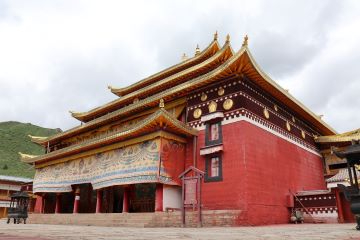The Wide and Narrow Alley

Name in Chinese: 宽窄巷子 Kuān Zhǎi Xiàng Zǐ [kwæ dzai ʃæŋ dzi]
Duration of Tour: One and a Half Hours
Location: No.116, Changshun Road, Qingyang District, Chengdu
Highlights: Traditional Chinese Northern-styled Folk Residence, Local Custom and Shopping
Reputations: One of the Three original Streets in Chengdu, One of the Top Ten Attractions in Chengdu
Located nearby Chengdu People’s Park, the Wide and Narrow Alley covers an area of 32 hectares(79 acres). It is one of the three original streets in Chengdu. The alley was built during the reign of Emperor Kangxi, the Qing Dynasty. In the year of 1688, the Zungar Khanate rose in revolt and annexed the nearby Mongol Khalkah Khanate. Both the former and the latter were vassals of the Qing Empire. Emperor Kangxi led his troops to suppress the rebellion. The war between the Qing Empire and the Zungar Khanate lasted from 1688 to 1758. Galdan Boshugtu Khan, the leader of the Zungar Khanate was defeated by the Qing’s army. He died in 1697. His nephew, Tsewang Arabtan succeeded to the throne. In the year of 1718, the successor waged a war against Dalai Lama, and took over Lhasa. Emperor Kangxi immediately sent his troops to Tibet to fight against the rebels. Two years later, the Zungar rebels were driven back to their home. Then, the Qing troops moved back and stationed in Chengdu. In ancient times, Chengdu comprised Shaocheng Town and Taicheng Town. Shaocheng means the smaller part of the city in English, and Taicheng refers to the larger one. The servicemen and their family members settled at Shaocheng Town and renamed it as Manchu’s Town. Manchu nationality was the ruling class of the Qing Empire. At that time, Han people were not allowed to enter the Manch’s Town. They lived in Taicheng Town which was renamed as Han’s Town. The Manchu people came from the northern China. They built their houses with a design of northern Chinese style. Manchu’s residence is called Siheyuan House in Chinese. That is the reason why Siheyuan houses can be found in Chengdu. Unlike Jinli Ancient Street, the Wide and Narrow Alley showcases the northern Chinese traditional architecture.
The alley is called Kuanzhai Xiangzi by local people. It consists of three lanes, namely Kuan Lane, Zhai Lane and Jing Lane. There are many souvenir shops in the lanes. The local products on sale are quite similar with those which can be found in Jinli Street, like Sicuan Embroidery, local snacks, tea and tea sets. Visitor can also kill time in tea houses, drinking tea and watching the local traditional live performances. The most impressive performance is the Face-changing. It refers to the painted masks changing of Sichuan Opera. The Face-changing has been listed as a national key intangible cultural heritage under protection.
Opening Hours:
Twenty-four Seven
Related Articles:
Jinli Street
Chengdu People’s Park
Chengdu Travel Guide
Author: Tina Luo
Update:
